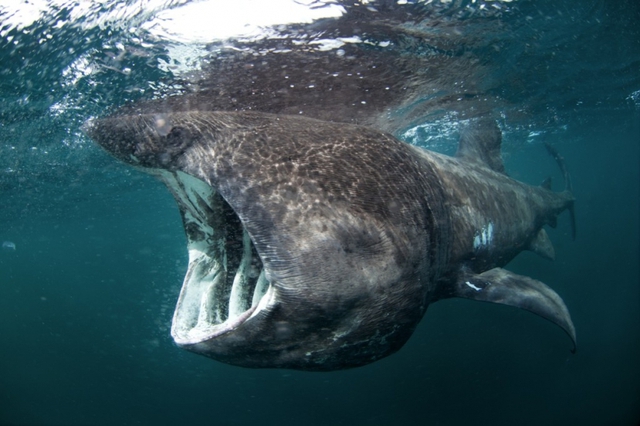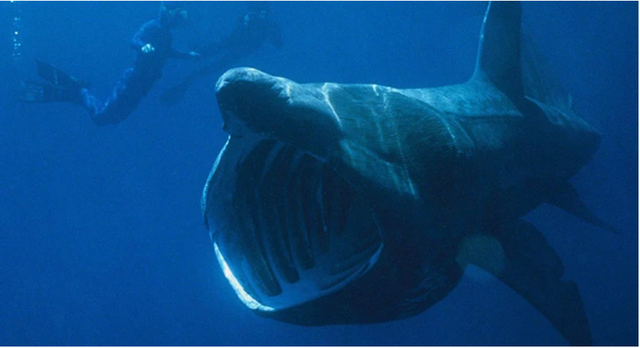The man unexpectedly encountered a “monster fish” washed ashore while jogging.
Giant “monster fish” washed ashore
According to Science Alert, on January 5, 2024, 72-year-old Stephen Davies was jogging on the beach near Liverpool Bay, England when he encountered an unexpected incident. He discovered a giant “monster fish” washed ashore.
Too surprised by the animal’s terrifying appearance, Mr. Stephen called the local police. According to him, at first he thought he had found the body of an alien or some kind of monster. He shared with Science Alert: “I was running on the beach and saw something very big. I’ve never seen anything like it before.”
After hearing the news, authorities stepped in to determine what this giant creature was. They eventually said it was the carcass of a basking shark.

While running on the beach, the man suddenly discovered a giant “monster fish”. (Photo: Science Alert)
The basking shark, also known as the basking shark (scientific name Cetorhinus maximus – meaning monster fish). The basking shark is currently the second largest living fish species, reaching a size of over 10m, second only to the whale shark. And although related to the great white shark, this animal is not a predator, as it mainly feeds on plankton.
It is huge, mysterious and was feared by sailors in the past.
The name “sunbathing” comes from their habit: crawling to the surface of the sea to catch the sun during the summer months. But when summer is over, these giant monsters disappear, down to a depth of at least 1,000m below the ocean floor.
The basking shark is a cosmopolitan species that can be found in most parts of the world. It prefers warm, temperate waters, between 8-14°C, but has recently been seen in much warmer waters closer to the equator. Basking sharks are usually found close to land. They typically swim in fairly shallow waters, but have been found at depths of up to 910 metres. Migration is a characteristic behaviour for this species, as is the case for tiger sharks and hammerhead sharks, which migrate to warmer waters in winter.

The basking shark is currently the second largest living fish species, reaching over 10m in size, second only to the whale shark. (Photo: Pixabay)
The body of the basking shark is typical of sharks. It has a long, spindle-shaped body and a massive size, so it can easily be mistaken for a great white shark. The gill arches contain special gill rakers, 10-14 cm long. Each arch contains up to 1000 gill rakers. Their function is to filter plankton. The snout of the basking shark is quite short and the mouth has 4 to 9 rows of small, curved teeth. The teeth are only 5-9 mm long, but there are up to 3,000 of them.
The fins of the basking shark are similar to those of other sharks, with a triangular dorsal fin, straight pectoral fins, and a crescent-shaped caudal fin. The colour of the basking shark varies and is likely to depend on viewing conditions and the health of the individual. Most are dark brown or dark grey on the back and lighter on the belly, but some individuals are completely dark.
Despite their large size, basking sharks are not active predators. They feed primarily on plankton by filtering water with their long gill slits. They can filter up to 1,800 tons of water per hour.

Basking sharks are listed as vulnerable by the IUCN due to overfishing. (Photo: Pixabay)
The basking shark is an oviparous species. Gestation can last from one to three years, and the young (usually one or two at a time) are born fully grown and 1.5–2 metres long. The basking shark reaches maturity at 2–4 years of age. Mating occurs in early summer, and females give birth in shallow water. The exact lifespan of the basking shark is unknown, but researchers have estimated that it can reach 50 years.
According to scientists, this basking shark found near Liverpool Bay is about 4.5 meters long and may still be young because adult basking sharks can grow up to 12 meters long.
They also believe it may die in winter and wash ashore after storms.
Basking sharks were once extremely common. But now they are listed as vulnerable by the IUCN due to overfishing.
News
Top 10 Most Beautiful Indian Actress in 2024 | Only Top10
Top 10 Most Beautiful Indian Actress in 2024 | Only Top10 Bollywood Actress: The Bollywood film industry holds a prominent position in Indian cinema, known for its grandeur and captivating storytelling. With their remarkable performances and exceptional acting prowess, numerous…
Who Is The Most Popular Bollywood Actress 2024?
Who Is The Most Popular Bollywood Actress 2024? Bollywood has always been home to some of the most talented and iconic actresses who have defined and redefined Indian cinema over the years. As we step into 2024, the competition is…
Reality of Malaika Arora and Arjun Kapoor’s div0®ce / Has Malaika Arora found a new boyfriend?
Reality of Malaika Arora and Arjun Kapoor’s div0®ce / Has Malaika Arora found a new boyfriend? Malaika Arora teases her relationship status for first time after Arjun Kapoor confirmed he is single Malaika Arora and Arjun Kapoor started dating in…
Alia being SHADY towards Sara? | Genelia takes a dig at Sonam Kapoor?
Alia being SHADY towards Sara? | Genelia takes a dig at Sonam Kapoor? Genelia Deshmukh’s Comment From A Clip Goes Viral Where Sonam Kapoor Was Called ‘Jealous’ Of Her Genelia Deshmukh dropped a comment on a reel that called out…
Shah Rukh Khan is the ULTIMATE role model: Life Lessons for Kids from the Bollywood Superstar
Shah Rukh Khan is the ULTIMATE role model: Life Lessons for Kids from the Bollywood Superstar Shah Rukh Khan, often called the King of Bollywood, is not only known for his exceptional acting but also for the life lessons he…
2nd time pregnant Alia Bhatt hide her baby bump at Raj Kapoor 100 anniversary celebration
2nd time pregnant Alia Bhatt hide her baby bump at Raj Kapoor 100 anniversary celebration Alia Bhatt, Sonam Kapoor THESE top B-town celebs moms whose maternity style is on point Here a list of Bollywood actress who has up their…
End of content
No more pages to load











